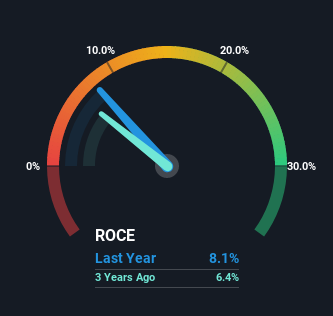
If we want to find a stock that could multiply over the long term, what are the underlying trends we should look for? Typically, we'll want to notice a trend of growing return on capital employed (ROCE) and alongside that, an expanding base of capital employed. Put simply, these types of businesses are compounding machines, meaning they are continually reinvesting their earnings at ever-higher rates of return. However, after investigating Shalby (NSE:SHALBY), we don't think it's current trends fit the mold of a multi-bagger.
Return On Capital Employed (ROCE): What Is It?
For those that aren't sure what ROCE is, it measures the amount of pre-tax profits a company can generate from the capital employed in its business. To calculate this metric for Shalby, this is the formula:
Return on Capital Employed = Earnings Before Interest and Tax (EBIT) ÷ (Total Assets - Current Liabilities)
0.081 = ₹851m ÷ (₹12b - ₹1.5b) (Based on the trailing twelve months to September 2022).
Therefore, Shalby has an ROCE of 8.1%. Ultimately, that's a low return and it under-performs the Healthcare industry average of 14%.
View our latest analysis for Shalby

Above you can see how the current ROCE for Shalby compares to its prior returns on capital, but there's only so much you can tell from the past. If you'd like, you can check out the forecasts from the analysts covering Shalby here for free.
So How Is Shalby's ROCE Trending?
The returns on capital haven't changed much for Shalby in recent years. The company has employed 51% more capital in the last five years, and the returns on that capital have remained stable at 8.1%. Given the company has increased the amount of capital employed, it appears the investments that have been made simply don't provide a high return on capital.
In Conclusion...
As we've seen above, Shalby's returns on capital haven't increased but it is reinvesting in the business. And in the last five years, the stock has given away 37% so the market doesn't look too hopeful on these trends strengthening any time soon. All in all, the inherent trends aren't typical of multi-baggers, so if that's what you're after, we think you might have more luck elsewhere.
One more thing to note, we've identified 1 warning sign with Shalby and understanding this should be part of your investment process.
While Shalby may not currently earn the highest returns, we've compiled a list of companies that currently earn more than 25% return on equity. Check out this free list here.
New: Manage All Your Stock Portfolios in One Place
We've created the ultimate portfolio companion for stock investors, and it's free.
• Connect an unlimited number of Portfolios and see your total in one currency
• Be alerted to new Warning Signs or Risks via email or mobile
• Track the Fair Value of your stocks
Have feedback on this article? Concerned about the content? Get in touch with us directly. Alternatively, email editorial-team (at) simplywallst.com.
This article by Simply Wall St is general in nature. We provide commentary based on historical data and analyst forecasts only using an unbiased methodology and our articles are not intended to be financial advice. It does not constitute a recommendation to buy or sell any stock, and does not take account of your objectives, or your financial situation. We aim to bring you long-term focused analysis driven by fundamental data. Note that our analysis may not factor in the latest price-sensitive company announcements or qualitative material. Simply Wall St has no position in any stocks mentioned.
About NSEI:SHALBY
Shalby
Engages in the operation of multi-specialty hospitals primarily in India, the United States, Japan, Indonesia, Oman, the United Arab Emirates, Bangladesh, Nepal, and internationally.
Reasonable growth potential with adequate balance sheet.
Market Insights
Community Narratives



